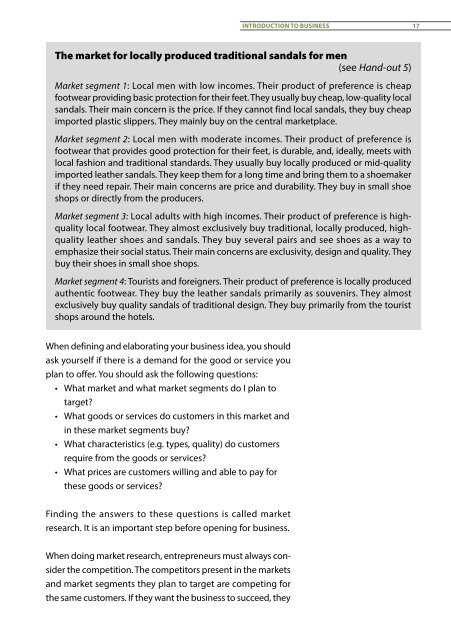new business module
You also want an ePaper? Increase the reach of your titles
YUMPU automatically turns print PDFs into web optimized ePapers that Google loves.
INTRODUCTION TO BUSINESS 17<br />
The market for locally produced traditional sandals for men<br />
(see Hand-out 5)<br />
Market segment 1: Local men with low incomes. Their product of preference is cheap<br />
footwear providing basic protection for their feet. They usually buy cheap, low-quality local<br />
sandals. Their main concern is the price. If they cannot find local sandals, they buy cheap<br />
imported plastic slippers. They mainly buy on the central marketplace.<br />
Market segment 2: Local men with moderate incomes. Their product of preference is<br />
footwear that provides good protection for their feet, is durable, and, ideally, meets with<br />
local fashion and traditional standards. They usually buy locally produced or mid-quality<br />
imported leather sandals. They keep them for a long time and bring them to a shoemaker<br />
if they need repair. Their main concerns are price and durability. They buy in small shoe<br />
shops or directly from the producers.<br />
Market segment 3: Local adults with high incomes. Their product of preference is highquality<br />
local footwear. They almost exclusively buy traditional, locally produced, highquality<br />
leather shoes and sandals. They buy several pairs and see shoes as a way to<br />
emphasize their social status. Their main concerns are exclusivity, design and quality. They<br />
buy their shoes in small shoe shops.<br />
Market segment 4: Tourists and foreigners. Their product of preference is locally produced<br />
authentic footwear. They buy the leather sandals primarily as souvenirs. They almost<br />
exclusively buy quality sandals of traditional design. They buy primarily from the tourist<br />
shops around the hotels.<br />
When defining and elaborating your <strong>business</strong> idea, you should<br />
ask yourself if there is a demand for the good or service you<br />
plan to offer. You should ask the following questions:<br />
• What market and what market segments do I plan to<br />
target?<br />
• What goods or services do customers in this market and<br />
in these market segments buy?<br />
• What characteristics (e.g. types, quality) do customers<br />
require from the goods or services?<br />
• What prices are customers willing and able to pay for<br />
these goods or services?<br />
Finding the answers to these questions is called market<br />
research. It is an important step before opening for <strong>business</strong>.<br />
When doing market research, entrepreneurs must always consider<br />
the competition. The competitors present in the markets<br />
and market segments they plan to target are competing for<br />
the same customers. If they want the <strong>business</strong> to succeed, they


